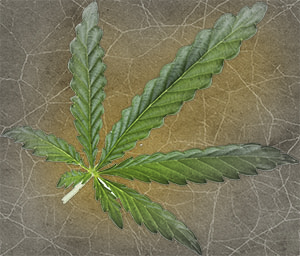Marijuana Addiction
 Marijuana is a highly addictive substance that is often promoted to be non-addictive or minimally addictive and harmless. In fact, marijuana is one of the top substances that people seek addiction treatment for each year surpassed by only alcohol. It is the most used illegal drug in the United States. According to the National Survey on Drug Use and Health (NSDUH) [1], “marijuana accounted for 4.5 million of the estimated 7.1 million Americans dependent on or abusing illicit drugs.”
Marijuana is a highly addictive substance that is often promoted to be non-addictive or minimally addictive and harmless. In fact, marijuana is one of the top substances that people seek addiction treatment for each year surpassed by only alcohol. It is the most used illegal drug in the United States. According to the National Survey on Drug Use and Health (NSDUH) [1], “marijuana accounted for 4.5 million of the estimated 7.1 million Americans dependent on or abusing illicit drugs.”
In recent years the technology of growing the drug has been refined, genetically altering it to become more potent than even just one generation ago. The National Institute on Drug Abuse (NIDA) states that marijuana potency has more than doubled since the 1980’s, and the business of growing marijuana has also evolved, generating praise to those who grow new hybrids or stronger strains. This endeavor has subsequently turned the horticulture process into what some view as an art form.
Growers are attempting to create powerful strains of marijuana due to the high demand and money associated with its sale, legal or not. In fact, much of the false information available today on marijuana and its addictive potential is directly due to its income potential for growers and those associated with its sale. Despite its income potential, marijuana is addictive and causes its consumers and their loved ones much distress. The highly potent substance is viewed as potentially innocent, but it is the ruin of countless lives.
WHAT IS MARIJUANA
Marijuana (Cannabis Sativa) is a leafy substance that can look greenish brown and is unique amongst hemp plants because of it production of the psychoactive chemical delta-9-tetrahydrocannabinol or THC. THC can be ingested by smoking or eating, but either way it is ingested it will target specific places in the brain called cannabinoid receptors, which are part of the neural network and are important to brain development. According to the NIDA [2], “Marijuana use impairs a person’s ability to form new memories and to shift focus.
THC also disrupts coordination and balance by binding to receptors in the cerebellum and basal ganglia—parts of the brain that regulate balance, posture, coordination, and reaction time. Therefore, learning, doing complicated tasks, participating in athletics, and driving are also affected…Marijuana use may produce anxiety, fear, distrust, or panic (and) marijuana users who have taken large doses of the drug may experience an acute psychosis, which includes hallucinations, delusions, and a loss of the sense of personal identity.” Marijuana can have many short and long term effects on the user, and addiction is more prevalent and happens much faster with today’s marijuana due to the increased THC content caused by genetic alteration and advanced growing methods.
ADDICTION TO MARIJUANA (PHYSICAL AND PSYCHOLOGICAL)
 Although it is perceived to be a recreational drug, it was found in a recent Substance Abuse and Mental Health Services Administration (SAMSHA) study, marijuana was reported to be the substance of abuse for 335,833 people in 2010, which is drastically up from 249,388 in the year 2000. This may be due to legalization efforts and the massive promotional campaigns behind this movement to seek the public acceptance of the drug. It is estimated by the NIDA that “9 percent of users become addicted to marijuana; this number increases among those who start young (to about 17 percent) and among daily users (to 25-50 percent)… Moreover, a study of over 300 fraternal and identical twin pairs found that the twin who had used marijuana before the age of 17 had elevated rates of other drug use and drug problems later on, compared with their twin who did not use before age 17.” According to SAMSHA, over 57% of first time users were under the age of 18, meaning that the likelihood of those smoking for the first time will become addicted.
Although it is perceived to be a recreational drug, it was found in a recent Substance Abuse and Mental Health Services Administration (SAMSHA) study, marijuana was reported to be the substance of abuse for 335,833 people in 2010, which is drastically up from 249,388 in the year 2000. This may be due to legalization efforts and the massive promotional campaigns behind this movement to seek the public acceptance of the drug. It is estimated by the NIDA that “9 percent of users become addicted to marijuana; this number increases among those who start young (to about 17 percent) and among daily users (to 25-50 percent)… Moreover, a study of over 300 fraternal and identical twin pairs found that the twin who had used marijuana before the age of 17 had elevated rates of other drug use and drug problems later on, compared with their twin who did not use before age 17.” According to SAMSHA, over 57% of first time users were under the age of 18, meaning that the likelihood of those smoking for the first time will become addicted.
A person becomes addicted to Marijuana just like any other major drug of choice. The person will start using the drug to solve a problem. In many cases the problems are things like a desire to fit in with peers at school, the need for excitement to escape boredom, as a relief from stress of work, or as a result of curiosity about the drug after having seen promotional campaigns with enticing scenes of cool people having fun while smoking pot. The person may also begin to use the drug to block out unpleasant memories that haunt them from bad times in the past. Regardless of their reason for use, an individual begins to use more of the drug and they begin to need the drug more. An interesting phenomenon occurs psychologically behind the addiction to marijuana. Every time the person uses marijuana to handle life’s problems or avoid pain and discomfort, their ability to confront other problems becomes weaker and weaker. In the case of marijuana addiction, spiritual atrophy occurs, causing a lessoning of confront for routine problems and day to day stresses of life. Eventually, this inability to cope can result in an individual who literally can’t confront paying bills, keeping a job, managing relationships, going to school, taking care of daily chores, developing valued pastimes, or staying active. The only thing they feel that they can do is smoke more marijuana.
Physically, during the beginning of the addiction, the marijuana user can experience the effects of nutritional deficiency [3,4] because THC burns up nutritional stores in the body as part of the metabolic process of breaking the drug down to get rid of it.
Marijuana metabolites the residual left behind after the drug is metabolized through the liver and kidneys, can store in the fatty tissues of the body for long periods of time after use. These stores of metabolites can be released back into the system later and act as a chemical reminder of the drug. This is the physical reminder which causes cravings in the individual when they are trying to abstain from using. If left unhandled these nutritional deficiencies can have a cascading effect and create more nutritional deficiencies in turn [5]. What can result is feeling bad, depressed, lethargic and in extreme cases, sickly. Since the person has become accustom to using marijuana to handle problems they tend to now use even more of the drug to feel better. This, of course, just creates more deficiencies and more feeling bad causing more drug use and continuing the cycle of addiction. Soon, the person is trapped into needing the drug to feel normal and the marijuana itself has become the problem.
MARIJUANA WITHDRAWAL
 Abstinence from marijuana can cause the user to show symptoms of irritability, unrelenting anxiety, sleeplessness or insomnia, decreased appetite, nausea, fixation on drug cravings, increased aggression, and one of the toughest symptoms associated with the physical withdrawal from marijuana; depression. Marijuana has a gradual effect on the body and mind; the body will take longer to fully recover its natural processes, and the user a longer time to feel mentally “normal” again. The reasons the user experiences physical withdrawal and depression are due to deteriorating nutrition from the damaged metabolic process and low production of chemicals (such as serotonin, dopamine and endorphins) in the brain. This is simply the physical aspect of the addiction, yet the mental urges (generated by signals from the body to the mind) to use once more in order to eradicate these symptoms are significant, and cause many to relapse. The withdrawals from THC and the ability of it to give the user a feeling of well-being are two major reasons for the high percentage of total abstinence failures/high percentage of relapses commonly found with long-term marijuana users.
Abstinence from marijuana can cause the user to show symptoms of irritability, unrelenting anxiety, sleeplessness or insomnia, decreased appetite, nausea, fixation on drug cravings, increased aggression, and one of the toughest symptoms associated with the physical withdrawal from marijuana; depression. Marijuana has a gradual effect on the body and mind; the body will take longer to fully recover its natural processes, and the user a longer time to feel mentally “normal” again. The reasons the user experiences physical withdrawal and depression are due to deteriorating nutrition from the damaged metabolic process and low production of chemicals (such as serotonin, dopamine and endorphins) in the brain. This is simply the physical aspect of the addiction, yet the mental urges (generated by signals from the body to the mind) to use once more in order to eradicate these symptoms are significant, and cause many to relapse. The withdrawals from THC and the ability of it to give the user a feeling of well-being are two major reasons for the high percentage of total abstinence failures/high percentage of relapses commonly found with long-term marijuana users.
SIGNS OF MARIJUANA ADDICTION
There are many signs that indicate a person may be getting addicted to marijuana, including inability to show up on time or pay bills, lack of enthusiasm, and reluctance to participate in everyday life events. These signs are often more visible to the individual themselves however they are reluctant to acknowledge these to others as that would be a sign of weakness or flawed personality. Still, the signs can be subtle or dramatic depending on the individual and their usage frequency. At one time the person may have used the drug every now and then, now they find themselves needing to have the drug around them much as possible and often begin using alone. When something occurs that appears to be a reason to quit using the drug like a loved one complains about the usage, the person will defend their “right” to use the drug and promote its non-addictive nature quoting from popular slogans used to gain public acceptance of the drug. The person may begin to spend more money on the drug and this can sometimes cause financial issues because of lack of funds. A person becoming addicted to marijuana may also make major life changes that indicate to loved ones that things are getting worse. The person may begin associating more and more with people who smoke pot and less and less with those who don’t.
This results in more and more social agreement to use the drug. The person may begin staying out later with those friends and going places to smoke pot they didn’t previously go to. They may change their dressing habits, eating habits, sleeping patterns, overall appearance among many other changes in life that cause those close to them to wonder what might be occurring. The signs of marijuana addiction forming can be subtle at times and then severe at others but if a person is observant they will detect the lifestyle and physical changes occurring as the person cycles round and round in the spiral of addiction.
SEVERITY OF MARIJUANA ADDICTION
When evaluating the severity of any addictive substance, it is important to separate the drug’s addictive potential from the addiction potential or propensity for addiction of the individual user. In other words, how addictive is marijuana and how likely is the individual user to succumb to that addictive potential. This is very hard to determine without actually witnessing the progression of usage, meaning there is no way to predict that potential. One person who seems well balanced and basically successful in life may experiment with marijuana and seem to do fine but then later encounter a major life issue which plunges them into heavy compulsive usage and thereby heavy addiction. Another person may seem to be reckless and addiction prone but then later discover the desire to reform their life into a more structured and successful form and simply drop the use of marijuana all together and never look back. One thing is certain. When hundreds of thousands of individuals per year find themselves desperately seeking help to escape the clutches of marijuana addiction, for them, life has become unmanageable at best and they have become destructive to themselves and others. A person addicted may lie daily to those who love them. They may steal to purchase the drug. The person addicted may commit crimes to support their habit including buying larger quantities of the drug and selling it illegally. The person can have major physical problems associated with its use and abuse like respiratory problems, impaired memory, increased heart rate or heart problems, panic attacks or worse. In short, Marijuana’s long-term relapse potential isn’t significantly better than commonly accepted addictive drugs such as alcohol and opiates. The severity of the addiction depends on how much the person uses and how long they continue using the drug to solve life’s problems.
TREATMENT FOR MARIJUANA ADDICTION
Treatment for all addiction starts with abstinence from the addictive drug, which can be done within the context of an organized withdrawal/detox component of a drug rehabilitation program. A marijuana treatment should use vitamins, minerals, amino acids to rebuild the person’s nutritional stores and bring the person’s body back into balance [6]. An effective treatment for this type of addiction will cleanse the body of residuals left behind after drug use has ceased. This will help end the cravings cycle and stop other negative physical manifestations of the drug stores being released back into the system.
Further, a treatment for marijuana addiction should offer a method of helping the person come to terms with the past, handle the guilt, shame and depression associated with past transgressions. As an addict progressed through their addiction they likely have unhandled upsets and bad relationships with family, friends, places of employment etc. The recovery program should have a method of helping the person confront these issues and situations and handle them in real life. This will be vital to rebuilding a successful life without marijuana. Finally a program would need to help the person identify a clear set of moral codes and key behaviors to keep them on the track to achieve their true goals and dreams in life and not take themselves back into a condition where they might use drugs again in the future.
Recovery from marijuana addiction is difficult. Like any other addiction, marijuana addiction encompasses a whole life and life style, not just one small aspect of life. Therefore, recovery will be across the various aspects of life and not isolated for instance to a physical phenomenon or a mental factor. Only truly comprehensive treatment will help the person rehabilitate all the aspects of life affected by marijuana so that the individual can once again live normally and happily without relapse.
References for Marijuana Addiction:
1. National Survey on Drug Use and Health: http://www.samhsa.gov/data/NSDUH/2k11MH_FindingsandDetTables/2K11MHFR/NSDUHmhfr2011.htm 2. How does marijuana use affect your brain and body: http://www.drugabuse.gov/publications/marijuana-abuse/how-does-marijuana-use-affect-your-brain-body 3. Hermann J: Drug – nutrient interactions: http://pods.dasnr.okstate.edu/docushare/dsweb/Get/Document-2458/T-3120web.pdf 4. Trovato A, Nuhlicek DN, Midtling JE: Drug-nutrient interactions: https://www.ncbi.nlm.nih.gov/m/pubmed/1950962/?i=2&from=/8197251/related 5. Bourre JM: Effects of nutrients (in food) on the structure and function of the nervous system: update on dietary requirements for brain. Part 2: Macronutrients. J Nutr Health Aging 2006, 10:386-99: http://www.bourre.fr/pdf/publications_scientifiques/259.pdf 6. Cook CC, Hallwood PM, Thomson AD: Vitamin deficiency and neuropsychiatric syndromes in alcohol misuse: http://alcalc.oxfordjournals.org/content/33/4/317.full.pdf

